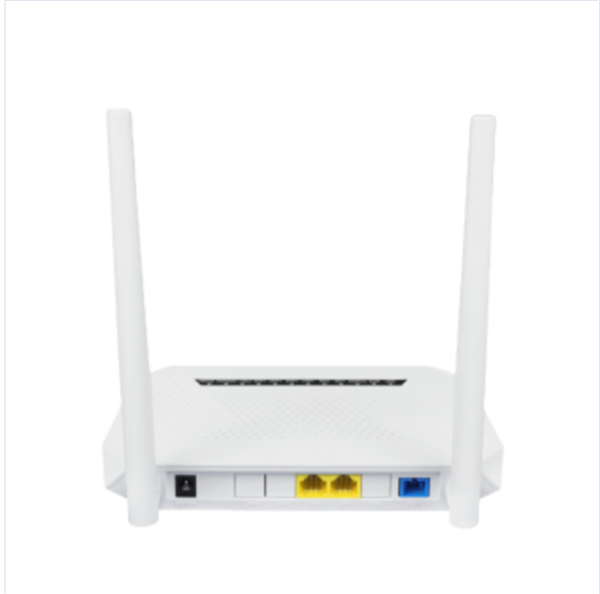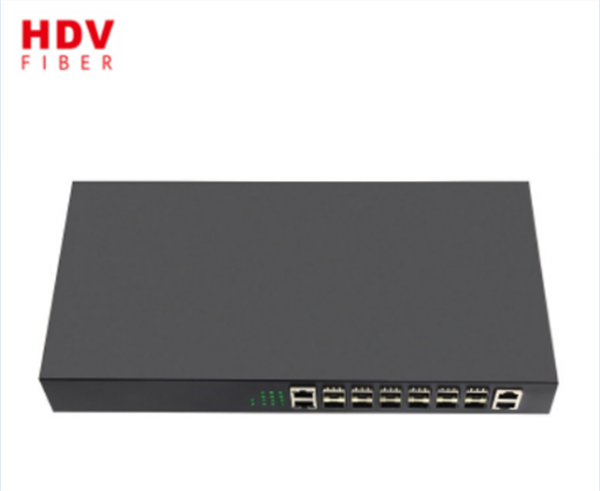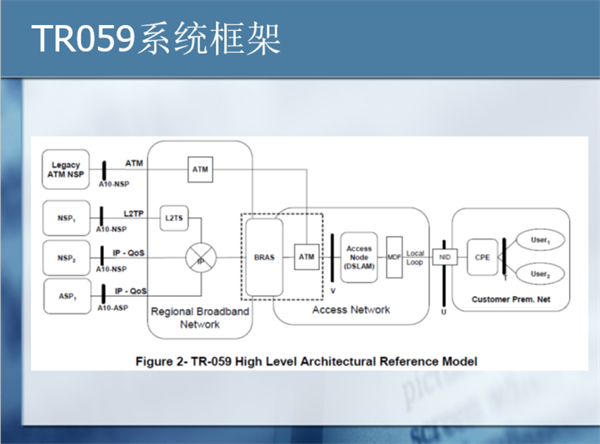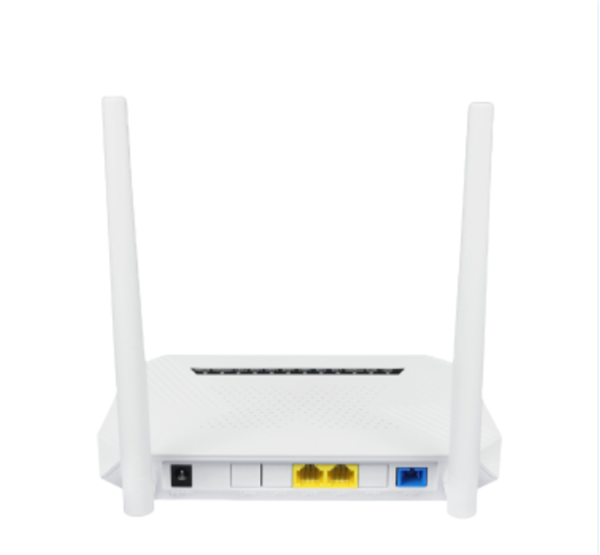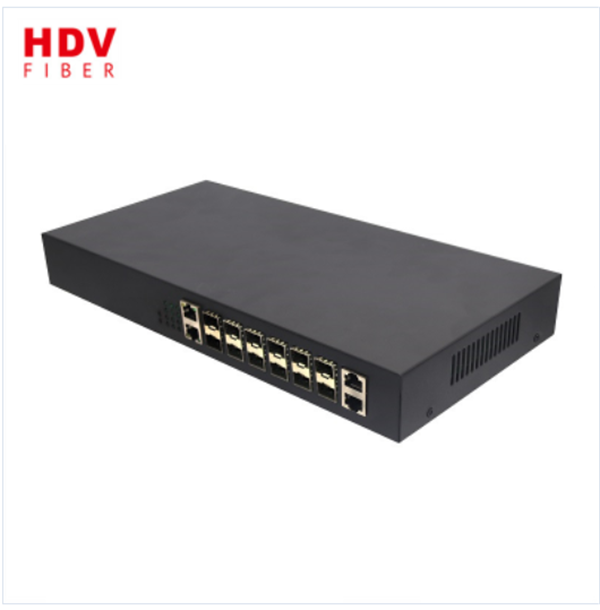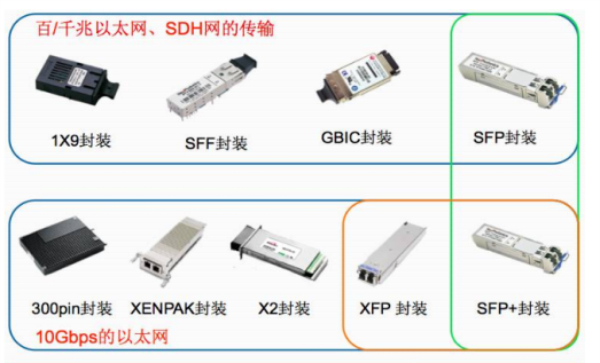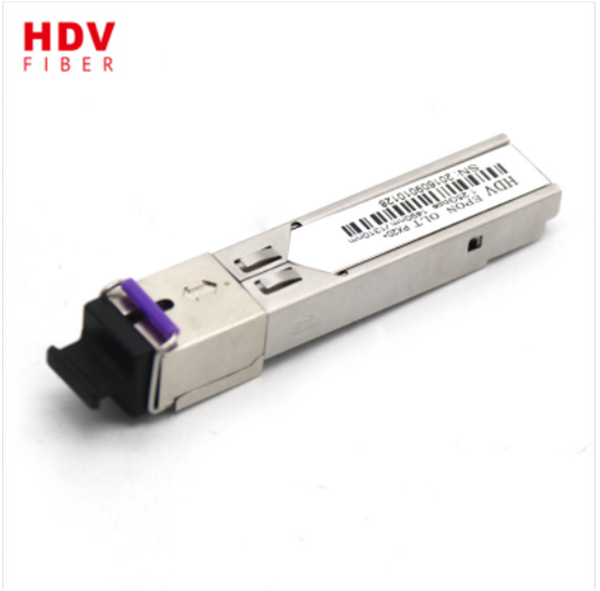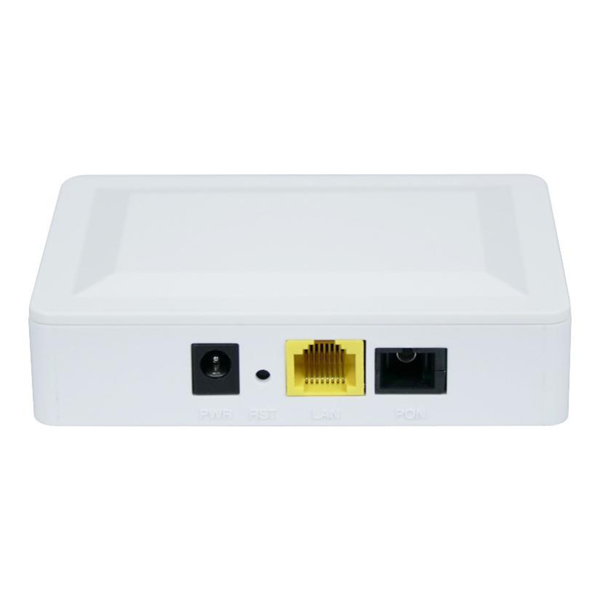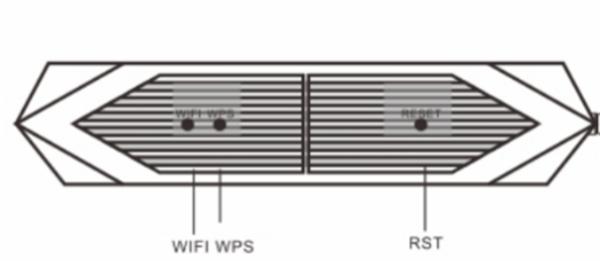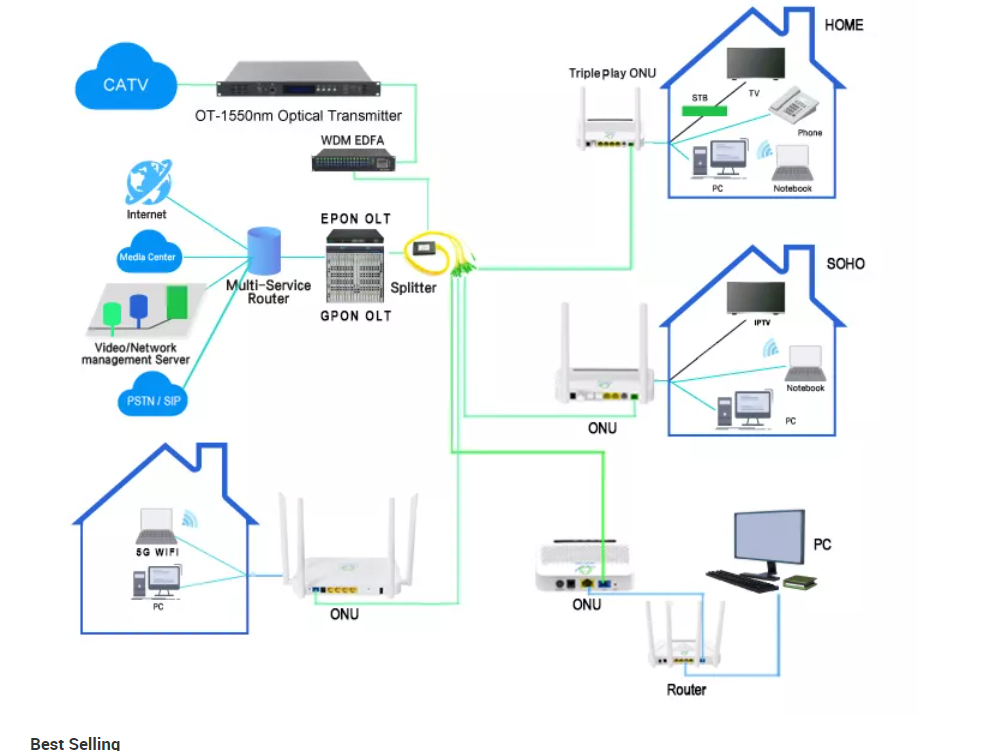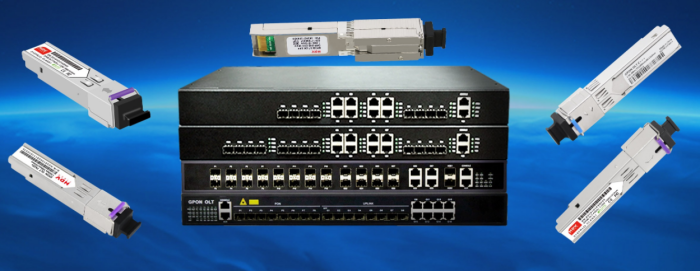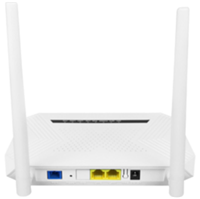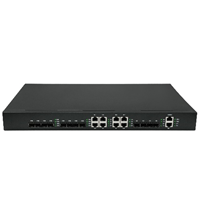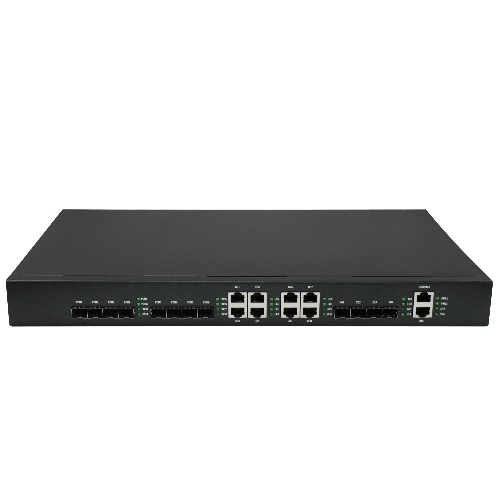In response to the product problems encountered by our customers, our company’s R&D engineers will timely reproduce the problems about XPON ONU/GPON ONU products according to the customer’s needs, and if necessary, will also reproduce the customer’s use environment and carry out the hang test in our R&D laboratory. The olt equipment of our company will also be used during the test, and the software function upgrade and bug handling will be carried out on it.
We will record the products under test, such as XPON ONU/GPON ONU, to form a mount log. In the mount log, the optical power of the intelligent ONU or the link of the optical fiber will be recorded. When we test the new driver version under GPON OLT and EPON OLT: SFU PPPOE untagged dialing under GPON during this period only needs to register and configure the service, without the command of ont port vlan 1 18 eth 1 transparent.
From your 8-port intelligent communication ONU optical cat module manufacturer
2. About OLT Equipment Maintenance
When the OLT device involves SFU service configuration, if the ONU type is SFU, and the ONU LAN port obtains the IP address assigned by the upper layer gateway, you need to add the VLAN configuration of the corresponding port ZXAN (config) # pon-onu-ng gpon-onu_ 1/2/1:6。 ZXAN(gpon-onu-mng 1/2/1:6)#vlan port eth_ 0/1 mode tag vlan 100
For CATV service configuration, refer to ONU support to control CATV switch ON/OFF through OMCI (ME82)
ZXAN(config)#pon-onu-mng gpon-onu_ 1/2/1:6
ZXAN(gpon-onu-mng 1/2/1:6)#interface video video_ 0/1 state lock
ZXAN(gpon-onu-mng 1/2/1:6)#interface video video_ 0/1 state unlock
From your telecommunication room OLT equipment manufacturer!
3. XPON ONU related network technology introduction
XPON ONU is a technology that is still developing, and its application in China is gradually expanding. China Telecom has formulated a standard. In the process of gradual improvement of the standard, due to the similar application and positioning of DSL and XPON ONU, mature management experience and technology in the DSL field have been selectively used for reference. TR101 represents the next development trend and technical/management requirements in the DSL field, and CTC XPON ONU will learn more or less from it
How to migrate from ATM-based DSL network (TR059) to Ethernet-based DSL network
Provide higher bandwidth and richer IP services (Video, VOIP, Gaming, L2VPN/IPVPN, etc)
Better IP QOS
Including technical and management requirements for core functions such as VLAN, QOS, Multicast, etc
4. 10G GPON ONU Technical Basis
Standard development of 10G GPON ONU:
(1) FSAN divides the next generation PON into two stages: NGA1 is based on TDMA PON to make higher speed. Its speed is defined as 10Gbps. NGA2 is a discussion of some more possible technology upgrades and some vague objectives of NG-PON1. For example, WDM PON, OFDM, etc. NG-PON can be well applied to FTTx, such as enterprise users, individual users and mobile backhaul.
(2)ITU NGA1 XGPON1: 10G GPON Asymmetric:Published G.987.1&G.987.2 ; G.987.3&G. 988 was published in June 2010.ITU NGA1 XGPON2: 10G GPON Symmetric:Discussion starts in 2010.Q1. One possibility is to overleap symmetric 10G GPON and directly migration to NGA2.
5. Construction of OLT equipment coding station environment
We are an OLT equipment manufacturer, and the environment construction of the coding station will be involved in our telecommunication room.
About the environment construction of Tftpd32 software:
1. Insert the serial cable into the OLT product. As shown in the figure below: the upper link is the serial port cable, and the lower link is the network cable.
2. Open the computer and select “Tftpd32″ software.
3. Select the local folder where Tftpd32 is installed.
OLT device code write-v8 software environment construction
1. Select OLT write-v8 software, right click to open its file location.
2. Update the corresponding upgrade file according to the OLT product requirements.
OLT device code write-v8 software environment construction
1. If the code is written successfully, the computer interface will display green “PASS”
2. After the code is written successfully, paste the corresponding Mac label paper on the rear left side of the OLT product.
6. Communication onu/optical fiber onu startup analysis
About what is uboot: uboot is actually a general boot program – bootloader. Boot, complete the hardware initialization, start the hardware platform loader, initialize the hardware, and load the operating system. Support various hardware, such as ARM, MIPS, X86, AVR32, RISC-V architecture, and various operating systems, such as WinCE, Linux kernel, Android operating system The role of uboot is to initialize the CPU in the first stage, write in assembly language, initialize cache, MMU, clock, watchdog, DDR3, eMMC, initialize in the second stage, and initialize at the board level. Generally, it is written in C language, initialize serial port, network card, usb, lcd, and provide many tools. Enter the uboot command line, use the command of uboot, and load the operating system.
About the Linux kernel:
The role of the kernel: process management and process communication: process creation and deletion, priority preemption between processes, time slice rotation scheduling of processes, and communication between processes. Memory management: memory allocation algorithm. The memory space of each process is allocated by Linux. Supported file systems can focus on Linux drivers: character devices, block devices, network devices, interrupts, and kernel clocks through cat/proc/filesystems, 4) device management. Network protocol: TCP/IP. The official website of the Linux kernel: https://www.kernel.org/
At present, our communication onu/optical fiber onu have entered our security monitoring, hotel network coverage and campus network coverage. If you want to know more about the internal knowledge of the product, please read other relevant documents!
7. ONU Product Foundation CLI
About our intelligent ONU product model:
1、flash set DEFAULT_ DEVICE_ NAME HUR2102XR//Device-Name on the web page
2、flash set GPON_ ONU_ Model reported to OLT in MODE HUR2102XR//GPON mode
3、flash set GPON_ ONU_ MODEL HUR2102XR//Models reported to OLT in GPON mode
4、flash set GPON_ ONU_ MODEL HUR2102XR//Models reported to OLT in GPON mode
Our company’s main products olt onu/ac onu/gpon onu/xpon onu/catv onu are all hot products of the company, which can cooperate with security monitoring, hotel network coverage and campus network coverage. If you are interested, you can contact us on our homepage. We have a professional R&D team, pre-sales and after-sales team. More standard production environment. There will be a professional senior business to introduce our company’s product information and the corresponding functions of the model to you before the sale, and a professional service team will escort you after the sale. Welcome!
8. Description of sfp optical fiber module
Definition of optical module: The optical module is composed of optoelectronic devices, functional circuits and optical interfaces. The optoelectronic devices include two parts: transmission and reception. In short, the function of optical module is photoelectric conversion. The transmitting end converts the electrical signal into optical signal. After transmission through optical fiber, the receiving end converts the optical signal into electrical signal.
Type of optical module:
1、 By package: 1X9, GBIC, SFF, SFP, XFP, SFP+, X2, XENPAK, 300pin
2、 Classification by electrical interface: hot plug (gold finger) (5g optical module/1.25g optical module/10g optical module), pin welding style (1 × 9/2 × 9/SFF)
Generally, the signal is more than 2.5G, and there is a certain loss of the signal when the pin welding method is used. When it exceeds 10G, you must use a gold finger. Therefore, the current high-end module electrical interfaces are all in the form of gold fingers. However, the advantage of row pin welding is that it is firmer than the gold finger. In some special cases, the row pin welding interface needs to be used.
If you want to know more about gigabit single-mode sfp optical module or other types of module products, please contact us at the home page!
9. SFP Communication Optical Module Structure
Although the package, speed and transmission distance of various types of optical modules are different, their internal composition is basically the same. The SFP transceiver optical module has gradually become the mainstream of application due to its miniaturization, convenient hot plugging, support for SFF8472 standard, convenient analog reading, and high detection accuracy (within+/- 2dBm). The following is an example of SFP optical module to introduce its internal composition and related working principles:
The basic composition of the optical module includes the following parts:
1. Optical device: optical device is a hybrid integrated device composed of a few optoelectronic components and IC, passive components (such as resistance, capacitance, inductance, mutual inductance, microlens, isolator), optical fiber and metal wiring, which are combined and packaged together to complete single or several functions.
2. Integrated circuit board (PCBA): The whole process of PCB empty board mounting through SMT (chip mounting) or through DIP plug-in, referred to as PCBA. Optical transmitting circuit/optical receiving circuit, chip (control chip, storage chip), amplifier (limiting amplifier), clock data recovery (CDR), golden finger
3. Shell: external accessories include shell (sheet metal upper cover), unlocking part, buckle, base (zinc alloy die-casting), pull ring, rubber plug, and the color of the pull ring can identify the parameter type of the module
10. Analysis of SMT (SMT) process difficulties of optical module PCB ‘A
The volume of the optical module itself is very small, and the component density on its corresponding PCB ‘A is large and the size is small. Generally, chip components are mostly packaged in 0402 package, and 0201 package is also gradually promoted. In addition, because the optical module needs to be connected with the system base station through the Golden Finger, the “pollution” problem of the Golden Finger in the SMT process also becomes one of the process difficulties.
In addition, due to the high degree of integration, some optical modules PCBA need to adopt some process innovation methods:
➢ Through hole connector (THC: Through Hole Component) adopts through hole reflow new process (THR: Through Hole Reflow);
➢ The flexible printed circuit board (FPC) and the hard printed circuit board (PCB) are welded by the combination of soft and hard boards (FoB: FPC on Board);
➢ 0402 new 3D real assembly welding process between chip resistance and capacitance (CoC: Chip on Chip).
Welcome to learn more about the product knowledge of communication optical module, pluggable optical module, 10MW optical module, optical communication module, network optical module and communication optical module on our company’s website. At present, optical module products can be applied to data communication, computer room consumables, security monitoring and industrial control.
11. Development Trend of Optical Modules
1. Miniaturization
At present, the competition in the optical communication market is becoming more and more fierce, the volume of communication equipment is becoming smaller and smaller, and the interface density contained in the interface board is becoming higher and higher. The traditional optical module separated from laser and detector has been difficult to adapt to the requirements of modern communication equipment. In order to meet the requirements of communication equipment for optical devices, optical modules are developing towards highly integrated small packages. Highly integrated optoelectronic modules enable users to process high-speed analog optoelectronic signals, shorten the R&D and production cycle, reduce the types of purchased components, and reduce production costs. Therefore, they are increasingly favored by equipment manufacturers.
2. Low cost and low power consumption
The volume of communication equipment is getting smaller and smaller, and the interface density contained in the interface board is getting higher and higher, which requires the optoelectronic devices to develop in the direction of low cost and low power consumption. At present, optical devices generally adopt hybrid integration process and air-tight packaging process. The next development will be non-air-tight packaging, which needs to rely on passive optical coupling (non-X-Y-Z direction adjustment) and other technologies to further improve the degree of automation and reduce costs.
3. High rate
People demand more and more information and faster information transmission rate. As the main pillar of modern information exchange, processing and transmission, optical communication network has been developing towards ultra-high frequency, ultra-high speed and ultra-large capacity. The higher the transmission rate and capacity, the lower the cost of transmitting each information.
4. Long distance
Today’s optical network is more and more far away, which requires remote transceivers to match it. The typical remote transceiver signal can transmit at least 100 kilometers without amplification. Its main purpose is to save the expensive optical amplifier and reduce the cost of optical communication. Based on the consideration of transmission distance, many remote transceivers choose 1550 band (the wavelength range is about 1530 to 1565 nm) as the working band, because the optical wave transmission loss is minimal in this range, and the available optical amplifiers are all working in this band.
5. Hot swap
That is, the module can be connected or disconnected from the device without cutting off the power supply. Because the optical module is hot-swappable, the network manager can upgrade and expand the system without shutting down the network, which will have no impact on online users. Hot plugging also simplifies the overall maintenance work and enables end users to better manage their transceiver modules. At the same time, due to this hot exchange performance, this module enables network managers to make overall planning for the transceiver cost, link distance and all network topologies according to the network upgrade requirements, without replacing all the system boards.
12. Basic Concepts of Switches
The traditional LAN uses HUB, which has only one bus, and one bus is a conflict domain. So the traditional LAN is a flat network, and a LAN belongs to the same conflict domain. Messages sent by any host will be received by all other machines in the same conflict domain. Later, the network bridge (layer 2 switch) was used to replace the hub (HUB) in the networking. Each port can be regarded as a separate bus, and the conflict area is reduced to each port, which greatly improves the efficiency of the network sending unicast messages and greatly improves the performance of the layer 2 network. If a host sends a broadcast message, the device can still receive the broadcast message. We usually call the range of broadcast message transmission as the broadcast domain. When the network bridge transmits the broadcast message, it still needs to make multiple copies of the broadcast message and send it to all corners of the network. With the expansion of the network scale, there are more and more broadcast messages in the network, and the broadcast messages occupy more and more network resources, which seriously affects the network performance. This is the so-called broadcast storm problem.
Due to the limitation of the working principle of the bridge two-layer network, the bridge can’t do anything about the broadcast storm. In order to improve the efficiency of the network, it is generally necessary to segment the network: divide a large broadcast domain into several small broadcast domains.
In the past, the LAN was often segmented through routers. The router in the figure replaces the central node switch in the previous figure, which greatly reduces the transmission range of broadcast messages. This solution solves the problem of broadcast storm, but the router is used to isolate the network in segments on the network layer. The network planning is complex, the networking method is not flexible, and greatly increases the difficulty of management and maintenance. As an alternative LAN segmentation method, virtual LAN has been introduced into network solutions to solve the problems faced by large two-layer network environments.
Virtual Local Area Network (VLAN) logically divides network resources and network users according to certain principles, and divides a physical actual network into multiple small logical networks. These small logical networks form their own broadcast domains, that is, virtual LAN VLANs. In the figure, a central switch is used, but the left and right belong to different VLANs, forming their own broadcast domains. Broadcast messages cannot be transmitted across these broadcast domains.
Virtual LAN logically divides a group of users on different physical network segments into a LAN, which is basically the same as traditional LAN in function and operation, and can provide interconnection of terminal systems within a certain range.
13. EPON ONU/GPON ONU Difference, April 6, 2022
Different standards (PON system)
EPON: IEEE 802.3ah. This standard combines Ethernet and PON technology. PON technology is used in the physical layer and Ethernet protocol is used in the data link layer to achieve PON network access
GPON: ITU-TG.984 series standard, based on the transmission convergence (TC) layer, can complete the adaptation of high-level diversity services
Different rates
EPON provides fixed uplink and downlink 1.25Gbps; EPON supports a maximum shunt ratio of 1:64;
GPON supports uplink and downlink asymmetric rate, with downlink 2.5Gbps or 1.25G and uplink 1.25Gbps;
GPON supports a maximum of 1:128 (theoretical value);
Application and development
EPON: relatively low cost and simple maintenance, which is the choice of most operators in the early stage
GPON: Perfect standards, good integrated service support and high technical requirements are the trend of optical access network
The GPON standard system is truly “open”, which is jointly discussed and improved by four major standards organizations (ITU-T SG15 Q2, FSAN, Broadband Forum, ATIS NIPP);
The EPON standard was initiated by IEEE and improved by operators in various countries, which is relatively “closed”
14. Basic Introduction to Software Functions of ONU Products
ONU software interface styles are divided into two types:
(1)Login Webpage
(2)Setting Webpage
ONU-Button:
Key: RST, WPS, WIFI
Location: side or front (hardware design)
Function: Reset to restore the factory settings, press and hold for 5-10S, and then release
WIFI enable, turn on or off WIFI function
WPS WIFI protection settings: press the WPS key, and the WPS indicator will flash. At this time, the WIFI client can use the WPS connection to complete the wireless network connection normally without entering the SSID password.
Optical fiber connectors used by our ONU products:
SC/UPC
➢ Subscriber Connector/Standard
➢ Push type, easy to load and unload
➢ is the most common connector. Light weight, small size, easy to operate
SC/APC
➢ Angled Physical Contact
➢ Grind and polish the microsphere surface at an angle of 8 degrees
➢ Return loss ≥ 60dB, commonly used in cable TV network to transmit CATV signal
Loop-Detect: Port loop detection: Send special messages on the device’s ports and detect whether the messages can be sent from. The destination port is received again to determine whether there is loopback on the port. If there is an alarm sent by the device, close the port. After the loop is cleared, reopen the port and report the alarm clearing.
When using ONU products, it will involve how we manage ONU:
Four management modes of ONU
WEB Management
CLI Management
OAM/OMCI Management
TR069/SNMP
15. ONU-OAM/OMCI
OAM
√ Operation, Administration&Maintenance
√ International standard IEEE 802.3 ah, domestic standard CTC 3.0
√ OAM is the interaction protocol between ONU and EPON OLT in EPON mode “discovery process” “link maintenance” “query and setting” “alarm”
OMCI
√ ONT Management&Control Interface “ONT Management&Control Interface”
√ International standard ITU-T G984. x ITU-T G988
√ OMCI is the interaction protocol between ONU and GPON OLT in GPON mode
SNMP — Simple Network Management Protocol
It is used for a management workstation to remotely manage all network devices that support the protocol, including querying network status, modifying network configuration, and receiving network event warning information. “Configuration Management” “Fault Management” “Performance Management” “Security Management”
The two key concepts of SNMP are MIB (Management Information Base) and OID (Object Identifier)
Management information base MIB: defines the management information that can be used on the device. The agent and management station use MIB as a unified data interface for communication
Object identifier OID: object managed by MIB (unique identifier)
For example, 1.3.6.1.2.1.1.1.0 Get basic system information (SysDesc)
16. Network Topology
√ WiFi can be networked through different network topologies, and its discovery and access to the network also has its own requirements and steps. WiFi wireless network includes two types of topology: infrastructure and ad-hoc. Two important basic concepts: station (STA): the most basic component of the network. Each terminal connected to the wireless network (such as laptop, PDA and other user devices that can be connected to the network) can be called a station. Wireless access point (AP): the creator of wireless network and the central node of the network. Generally, the wireless router used in the home or office is an AP. Channel, key (such as WEP), network protocol (such as DHCP), bridging, etc. need to be set. The clients are desktop, notebook, handheld computer and other user devices.
√ Basic wireless network based on AP
√ Created by AP and composed of many STAs
√ AP is the center of the whole network
√ The STA cannot communicate directly with each other and needs to be forwarded by the AP. The following is the production topology of our company’s GPON OLT/XPON OLT/OLT ONU/AC ONU/telephone ONU/WIFI ONU/CATV ONU for reference:
17. OSI 7-Layer Network Architecture
√ Physical layer: 802.11b defines the data transmission rate of 11Mbps working in the 2.4GHz ISM frequency band The physical layer uses frequency-hopping spread spectrum transmission technology (Frequency-hopping Spread Spectrum, FHSS) and Direct Sequence Spread Spectrum,DSSS)
√ MAC layer: MAC layer provides multiple functions to support wireless network operation. Through MAC layer site You can establish a network or access an existing network and transmit data to the LLC layer.
√ LLC layer: IEEE802.11 uses the same LLC layer and 48-bit MAC address as IEEE802.2 Address, which makes the bridge between wireless and wired very convenient. But MAC address is only unique to WLAN determine.
√ Network layer: IP protocol is adopted, which is the most important protocol in the Internet Guidelines to be followed when communicating on.
√ Transport layer: TCP/UDP protocol is adopted. TCP is a connection-oriented protocol and can provide IPReliable transmission under the environment; UDP is a connectionless protocol that does not provide reliability for IP
√ Transmission. For highly reliable applications, the transport layer generally adopts TCP protocol. Application layer: implemented according to application requirements, such as HTTP protocol, DNS (Domain name System, domain name resolution system) protocol. At present, Haidiwei mainly provides network layer and transmission layer equipment, such as: all-optical switch, SFP optical module, GPON OLT, GPON ONU series, as shown in the following figure:
18. ONU+STB Gateway Box, April 7, 2022
At present, as a user terminal device, ONU is a separate device independent of the digital TV set-top box. It is connected to the set-top box system through the user interface of ONU in the EPON system. When the next generation of transmission network develops to FTTH, each household needs two terminal devices, one set-top box and one ONU, which will waste user space and increase user consumption burden. At this time, a 9602C ONU+STB product technology has become the goal of the industry. By integrating the functions of ONU into the set-top box, the function of the set-top box will be more powerful, the data processing speed will be faster, and the application prospect will be wide.
At present, the development of IPTV is mainly faced with the technical bottleneck of how to break through the limitation of broadband, and the real significance of the penetration of telecommunications optical fiber into the home. The 10G-PON access optical network can not only allow users to listen to and watch a series of rich and wonderful audio-visual programs such as HD, UHD, 3D, but also provide users with powerful Internet services such as online medical care, online teaching, online e-commerce, voice chat, video communication, etc, It can even play the role of housekeeper in the user’s home, providing users with excellent home security, home Internet of Things and other smart home services. In order to solve the above problems, Shenzhen Haidiwei Optoelectronic Technology Co., Ltd. proposed the “9602C ONU+STB” R&D project. For this purpose, it is dedicated to technical upgrading, researching more high-tech and high-volume technical support, and researching more new and truly suitable network equipment for the majority of groups.
19. MINI Square ONU
The current ONU equipment is mainly composed of ONU chip, BOSA (Bi-direction Optical Subassembly) bidirectional optical transceiver module, power module, printed circuit board and protective shell; The ONU chip, optical module and power module are packaged on a printed circuit board; One end of its BOSA is a connector with pigtail, which is fixed on the printed circuit board and used for docking with the optical fiber connector from the optical line terminal OLT; The other end of BOSA is also connected with a PCB board; This structure leads to a large volume of the entire ONU product, occupies space and is not easy to install, and it is difficult to leave the optical fiber tray. There will always be a section of optical fiber exposed, which is extremely vulnerable to a series of problems such as fiber breakage and signal conversion failure caused by external forces. In order to solve the above problems, the “MINI ONU square” research and development project was put forward. For this purpose, technical improvement was carried out, more high-tech and high-volume technical support was studied, and more new and truly suitable network equipment was researched. Shenzhen Haidiwei Optoelectronics provides various types of GPON ONU/WIFI ONU/ODM services, providing one-stop service for customers of this type of business.
20. MINI Transceiver
The traditional optical fiber transceiver is an Ethernet transmission media conversion unit that exchanges short distance twisted pair electrical signals and long distance optical signals, which extends the connection distance of Ethernet and breaks the distance limit of 100 meters using twisted pair. Optical fiber transceivers are generally used in the actual network environment where the Ethernet cable cannot cover and optical fiber must be used to extend the transmission distance, and are usually positioned in the access layer application of broadband metropolitan area network. Generally, the electrical interface of optical fiber transceiver on the market is directly connected with the main chip. In case of sudden change of input voltage or current, the transmission rate and quality will be affected, and the main chip will be easily damaged. In order to solve the above problems, the “IC+175 MINI transceiver” R&D project is proposed: to improve the technology, study more high-tech and high-volume technical support, and study more new and truly suitable network equipment for the majority of groups. At the same time, our company requires the financial department to set up an independent accounting account for the research and development costs of the project, and the funds are subject to special fund management. The technical department must strengthen project management, and other departments of the company shall provide assistance and cooperation according to the requirements of the R&D project team to ensure the smooth implementation and completion of the project. Shenzhen Haidiwei Optoelectronic Technology Co., Ltd. provides optical fiber switch and ODM services
21. Powered POE nano transceiver
In the traditional optical fiber wiring installation process, photoelectric conversion equipment needs to be installed, while the existing photoelectric conversion equipment uses a single power supply mode, that is, to obtain working power from other power supply equipment to maintain stability. However, when the power acquisition port of the photoelectric conversion equipment fails, or the power supply party fails, the photoelectric conversion equipment will not work normally, thus greatly affecting the working process. In order to solve the above problems, the “IC+nano PD POE transceiver” R&D project is proposed: to improve the technology, study more high-tech and high-volume technical support, and study more new and truly suitable network equipment for the majority of groups. At the same time, our company requires the financial department to set up an independent accounting account for the research and development costs of the project, and the funds are subject to special fund management. The technical department must strengthen project management, and other departments of the company shall provide assistance and cooperation according to the requirements of the R&D project team to ensure the smooth implementation and completion of the project.
22. Optical Network Unit ONU
OLT: optical line terminal, which manages multiple terminal devices (ONUs). It is also a device at the external network entrance and the internal network entrance. Role: provide network side interface for optical access network and communicate with ONU on user side through one or more ODNs. The relationship between OLT and ONU is master-slave communication. ODN: optical distribution network, commonly known as optical splitter. The optical path signal of a trunk line is distributed to equipment on multiple terminals (ONUs). Role: It provides optical transmission means between OLT and ONU. Its main function is to complete the assignment of optical signal power. ODN is a purely passive optical distribution network composed of passive optical components (such as optical fiber and cable, optical connector and optical splitter). ONU: optical network unit; Generally, it can be understood as a home router or switch. The main difference between the equipment used in the ordinary twisted pair network is that there is an additional optical network port. Function: It provides the remote user-side interface for the optical access network, which is located at the user side of the ODN. OAN is an access network using optical fiber transmission technology, that is, a communication system between the local switching office and users using optical fiber transmission in whole or in part. Optical access network can be divided into passive optical network (PON) and active optical network (AON). Compared with these two kinds of optical networks, the development of passive optical network will be faster in terms of cost. According to the specific location of ONU in the optical access network, OAN can be divided into several basically different application types: 1) Optical fiber to junction box (FTTCab) 2) Optical fiber to roadside (FTTCub) 3) Optical fiber to building (FTTB) 4) Optical fiber to home (FTTH) and optical fiber to office (FTTO) PON technology: PON is a single-fiber two-way optical access network with point-to-multipoint (P2MP) structure, and its typical topology is tree type
23. How to distinguish optical access network OLT and ONU
What is OLT?
The full name of OLT is Optical Line Terminal. OLT is an optical line terminal, which is the office end equipment of telecommunications. It is used to connect optical fiber trunk lines. It acts as a switch or router in the traditional communication network, and is a device at the entrance of the external network and the entrance of the internal network. At the office end, the most important execution functions are traffic scheduling, buffer control, and user-oriented passive optical network interface and bandwidth allocation. In simple terms, it is to realize two functions: upstream access to PON network; For the downstream, the acquired data will be sent and distributed to all ONU user terminal devices through the ODN network.
What is ONU?
ONU is the optical network unit. ONU has two functions: to selectively receive the broadcast sent by OLT, and to receive and respond to the OLT if it needs to receive the data; Collect and cache the Ethernet data that users need to send, and send the cached data to the OLT terminal according to the allocated sending window.
In the FTTx network (click here to quickly learn about FTTx), different deployment methods of ONU access are also different, for example, FTTC (Fiber To The Curb): ONU is placed in the central computer room of the cell; FTTB (Fiber To The Building): ONU is placed in the junction box of the corridor; FTTH (Fiber To The Home): ONU is placed in the home user.
24. About How to Use Gigabit Optical Modules with Switches
How to match optical modules and switches has always been a hot issue in the industry. The match between switches and optical modules not only determines whether they can be used normally after connection, but also affects whether the network system can be upgraded with low cost and high efficiency in the later stage. Therefore, HDV will focus on how to use gigabit optical modules with switches. For the switch, the optical port of the frame switch is generally able to support the use of gigabit optical module for the 10-gigabit optical port, and the use of the 100-gigabit optical module for the gigabit interface, that is, speed down. However, the uplink optical port of the box switch does not support the above speed reduction, and the downlink optical port can support the above speed reduction under normal conditions. However, it is generally not recommended to reduce the speed of the light port. Therefore, gigabit optical module and gigabit switch are the best choice.
The gigabit optical module is based on different application scenarios: data communication, computer room consumables, data center, security monitoring, and industrial control.
25. Our OLT Equipment
OLT is an optical line terminal. It is an OLT network management system based on CLI, WEB and NMS, which is used to connect the terminal equipment of optical fiber trunk. Based on the theoretical system of EPON system, OLT understands its working principle, analyzes the business requirements of optical line terminals, distinguishes the main functional modules, and discusses the functions of each part of EPON system. The advantages of OLT are small size, simple equipment, low installation and maintenance costs, and relatively small investment. Passive optical equipment is flexible in networking, and its topology can support tree, star, bus, hybrid, redundant and other network topologies. Easy to install, it has indoor and outdoor types. Its exterior shape can be directly hung on the wall or placed on the “H” pole, without renting or building the machine room. However, the active system needs photoelectric and electro-optical conversion, and the equipment manufacturing cost is high. It needs to use special sites and machine rooms. The problem of remote power supply is difficult to solve, and the daily maintenance workload is large. Passive optical network is suitable for point-to-multipoint communication. Only passive optical splitter is used to realize optical power distribution. Passive optical network is a pure medium network, which completely avoids electromagnetic interference and lightning impact, and is extremely suitable for use in areas with poor natural conditions. From the perspective of technology development, the expansion of passive optical network is relatively simple, and does not involve equipment transformation. Only equipment software upgrade is required. Hardware equipment is purchased once and used for a long time, which lays the foundation for optical fiber to enter the home and ensures the investment of users.






